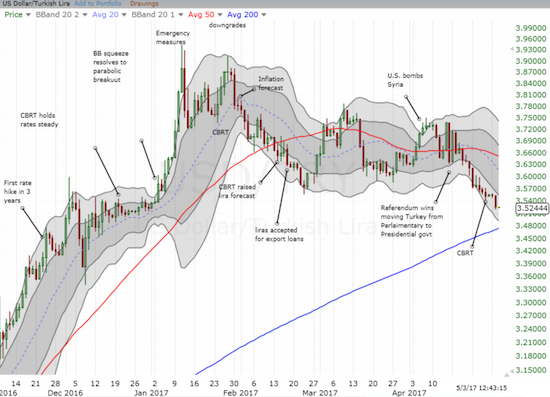The verdict is almost in: the Turkish lira is overcoming its headwinds.
After the results of Turkey’s constitutional referendum in mid-April, the Turkish lira bounced around in indecision. Against the U.S. dollar, the indecision ended in conjunction with the April 28th release on monetary policy from the Central Bank of the Republic of Turkey (CBRT). In that release the CBRT increased its inflation forecast and sounded a relatively upbeat outlook for the Turkish economy.
The CBRT revised upward its inflation forecasts for year-end 2017 by 0.5 points to 8.5%. The year-end forecast for 2018 increased 0.4 points to 6.4%. The CBRT expects inflation to peak from here: “Inflation is expected to reach the highest levels in April-May particularly due to the base effect from unprocessed food and the lagged effects of the exchange rate, and then to fall thereafter as the impact of last year’s price increases in energy, alcohol-tobacco products and food gradually diminishes.” Yet, the CBRT does not feel compelled to take specific anti-inflationary measures because it expects existing tight monetary policy to “support the disinflation process.”
The forecasts likely were forced upward because of the recent surge in inflationary pressures:
“Consumer inflation has surged since November 2016 and rose above the upper band of January forecasts. The upward trend in inflation was largely driven by the depreciation in the Turkish lira and the rise in import prices in addition to the increase in food prices. The rapid depreciation in the Turkish lira spread across the consumer price index, particularly to energy and durable goods items.”
The inflation push did not prevent the CBRT from issuing a relatively optimistic outlook on the economy:
“In sum, the recently released data indicate a gradual recovery in the economic activity. Domestic demand conditions display a moderate improvement and demand from the European Union economies continues to contribute positively to exports. With the supportive measures and incentives provided recently, the economic activity is expected to gain further pace in the forthcoming period. However, the course of capital flows in line with uncertainties regarding global economic policies, geopolitical developments, the subsided course of the labor market and the lingering volatility in exchange rates may stand out as factors to limit the pace of growth in 2017…
Downside risks to economic activity have recently abated. The growth outlook for 2017 is expected to be more favorable compared to 2016 which was subject to numerous concurrent adverse shocks.”
Taken together, the news is not dripping with bullishness for the Turkish lira, but, likely more importantly, the news does not flag any new warnings AGAINST the lira. With the lira slowly but surely strengthening, I took this news as reason enough to stop out of my long USD/TRY position. Depending on the reaction to the U.S. Federal Reserve’s next pronouncement on monetary policy (Wednesday, May 3rd), I will likely look to play USD/TRY short for a test of critical support at its 200-day moving average (DMA)…and an eventual breakdown.
Both USD/TRY and EUR/TRY are in different stages of a short-term downtrend defined by the lower-Bollinger Bands (BBs).


Source: FreeStockCharts.com
The chart of USD/TRY highlights some of the major headlines that recently weighed on the lira. The currency has done well to avoid breaking out above 4.0. Now, a test of 200DMA support will roughly coincide with the lira’s level when the CBRT delivered its first rate hike in the previous three years (see November 24, 2016). I will reassess my read of the lira if USD/TRY manages to close above the now downtrending 50DMA.
Be careful out there!
Full disclosure: no positions

Dear Doc, I understand you are more of the view that USD/TRY will break the 200 DMA downwards. Am I right? And if so, how far down it will go to take a long position? Thanks.
I think it will eventually. Hard to say how long it will take. USD/TRY has churned for a few months now, so a break should not happen quickly. But at least you get paid well to wait…